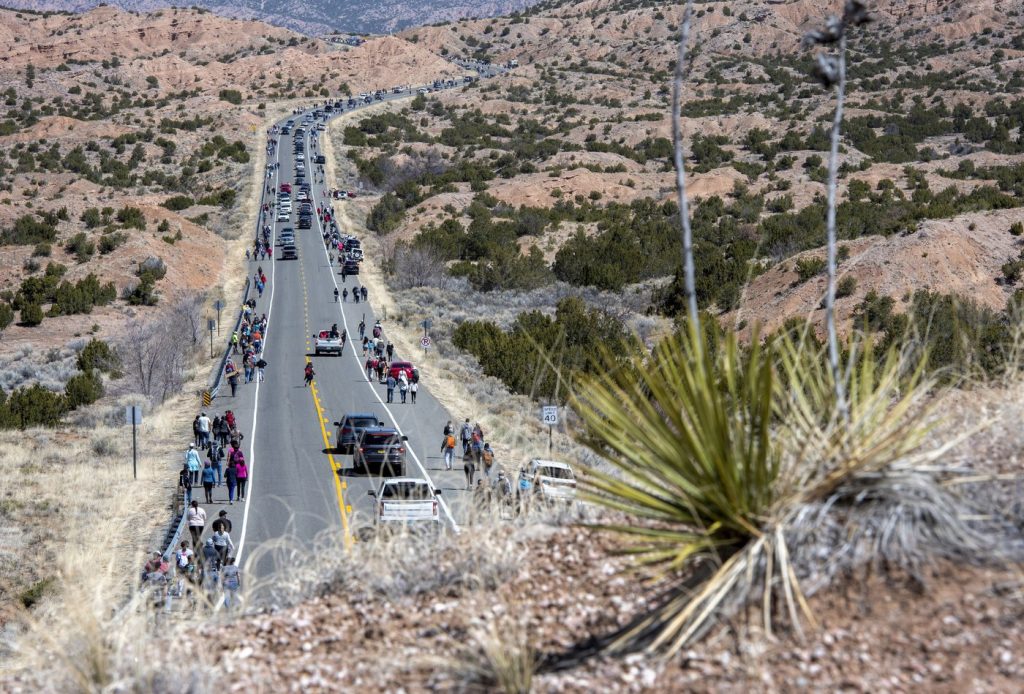SANTA FE, N.M. (AP) — A distinctive Holy Week tradition is attracting thousands of Catholic pilgrims to a small adobe church nestled in the hills of northern New Mexico. This journey on foot through the desert badlands culminates at a revered spiritual site known as El Santuario de Chimayó, where many come to commemorate Good Friday.
The pilgrimage has been a part of life for generations, with individuals and families from the Upper Rio Grande Valley and beyond making the trek to the church. Many pilgrims endure walks that last several days, arriving on Good Friday amidst forecasts of cool temperatures and light rain. Central to their journey is an indoor well filled with local dirt, believed to possess healing properties. These pilgrims often leave behind crutches, braces, and canes as acts of prayer for their loved ones, reinforcing their faith in the miracles that occur at the site.
During Easter week, visitors enter the sanctuary through an adobe archway, navigating narrow corridors to reach the main altar, which houses a crucifix of Nuestro Señor de Esquipulas. According to local lore, this crucifix was discovered in the early 1800s on a site that held sacred significance long before the arrival of Spanish settlers.
Chimayó itself, famous for its artisan weavings and chile production, sits high above the Rio Grande Valley. The iconic adobe church, constructed from local mud at the twilight of Spanish rule in the Americas, recalls a time when Native Americans held the area as sacred. Surrounded by narrow streets, curio shops, and swift brooks, El Santuario de Chimayó is designated as a National Historic Landmark, showcasing 19th-century Hispanic folk art, religious frescoes, and intricately carved wooden saints known as bultos.
Inside one room, countless notes of gratitude adorn the walls, left by those who claim to have experienced miraculous healings. A separate chapel dedicated to Santo Niño de Atocha serves as a sanctuary for children, travelers, and those seeking liberation. Pilgrims often leave behind children's shoes here, a tribute to the holy child who is said to wear out footwear on miraculous errands. Tiny boots can even be seen tacked to the ceiling as additional offerings.
The Pueblo people who resided in the Chimayó region long before the Spanish colonization believed in the powers of healing spirits found in hot springs. Although those springs have since dried up, the earth remains regarded as possessing restorative qualities. Photographer Miguel Gandert, who grew up in the Española Valley, remembers making the pilgrimage with his family as a child. “Everybody went to Chimayó. You didn’t have to be Catholic,” he recalled, noting that the spiritual significance of the site drew people from various backgrounds.
Scenes from the 1996 pilgrimage, captured through a federal grant, are currently on display at the New Mexico History Museum in Santa Fe. These images depict the diverse crowds who journey to Chimayó, including children enjoying snow cones, men carrying large wooden crosses, and weary travelers resting along the roadway. Today, Good Friday pilgrims persist in this tradition, bringing their crosses, leaving vehicles behind, and allowing time for older hikers to join the walk.
This tradition stands as a testament to the role of adobe churches in shaping the unique New Mexican way of life. Yet, many of these churches are at risk of crumbling due to neglect as congregations decline and traditional practices fade into the background. Each year, pilgrims set out from their homes before dawn, some traveling as much as 20 miles (32 kilometers) from Santa Fe or embarking on longer journeys from places like Albuquerque, often taking days to complete their sacred trek.
While on their pilgrimage, vendors line the roadside selling religious trinkets, coffee, and snacks. State transportation officials, law enforcement, and volunteers work diligently along the pilgrimage route to ensure the safety of walkers against traffic and the elements. The arid landscape that pilgrims traverse gives way to the lush greenery surrounding Chimayó, creating a striking contrast as they approach the sanctuary. This religious pilgrimage is unmatched in the United States, with many participants reflecting on not only their faith in Jesus Christ but also on their prayers for the well-being of loved ones and their broader community.










